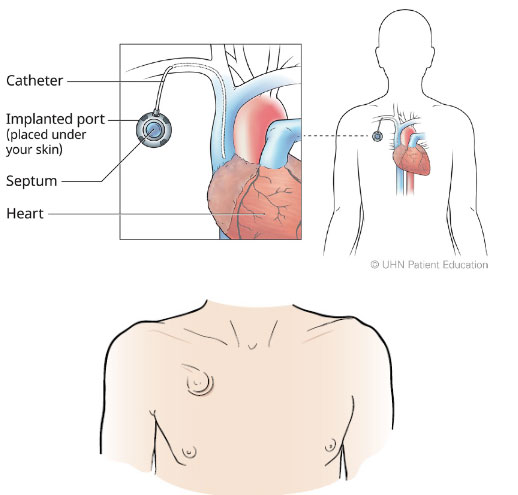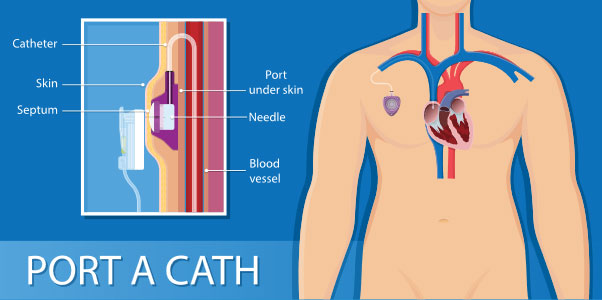WHAT IT IS AND WHY DO I NEED IT?
An implantable chamber (also known as a ‘port’) is a device, placed under the skin in a surgically created pocket, that provides access to your large central veins. The port is accessed using a special needle which is inserted through the skin into the chamber. This allows you to be given all your intravenous medications and fluids as well as blood samples taken without having to insert a needle into your arms.
Your nurse can use your port to collect blood samples, and to give:
- Fluids
- Medicines, like chemotherapy and antibiotics
- A blood transfusion
- IV nutrient (food) – this is called parenteral nutrition.
A port can be left in place for months or even years, depending on your treatment, and as long as it is working well and shows no signs of infection. Your doctor will remove your port when you don’t need it anymore.
It is important for you and your family to know about your port, how to use it and how to take care of it so that you can get the best out of it.
WHAT DOES IT LOOK LIKE AND WHERE DOES IT GO?
A port consists of a reservoir port (the chamber), a silicone catheter and a central ‘septum’ or access site. The septum can withstand 1000-2000 needle punctures.

Implanted ports are usually placed about 2-3 centimetres below the centre of your right collarbone. If you wear a bra, your implanted port will be about 1 cm from where your bra strap lies. Your implanted port may raise your skin about 1.2 centimetres. You may be able to feel it through your skin, but you probably won’t be able to see it when you wear a V-neck shirt. Most people won’t know that you have it.
HOW IS AN IMPLANTABLE CHAMBER PLACED IN THE BODY?
A port is usually inserted as a day procedure performed in the operating theatre by an anaesthetist. You will be admitted to the Day Ward 1 or 2 hours before the procedure. Your doctor or nurse will tell you how to prepare for it. You may be given a general anaesthetic, or may only need sedation to make you feel sleepy and relaxed. The port is then inserted with local anaesthetic to numb the insertion site.
The anaesthetist will make 2 small incisions (cuts), one at the base of your neck and another on your chest about 2 to 3 centimetres below your collarbone. The port is first inserted into the opening (‘pocket’) on your chest. The doctor then tunnels the catheter under your skin towards the cut at the base of your neck and into one of your main vessels in the chest (the superior vena cava).

The chamber is stitched to the muscle to hold it in place. A sterile tape or suture is placed over your incisions and covered with a dressing to prevent infection. The whole procedure takes about 30 to 45 minutes. The sutures will be removed by your doctor after a few days.
For 3 to 5 days after your implanted port is placed, don’t lift anything heavier than 5 kilograms. Also, avoid putting pressure on the incision areas such as wearing suspenders or a tight bra for the first 2 days.
Following your port insertion, it is normal to experience some redness and tenderness in the area of the incision which subsides in after 24-48 hours. If you notice unusual changes in the skin area over the port such as increased swelling, redness or soreness you should contact your doctor.
Call your anaesthetist or come to the A&E department if you:
- Have new or increased pain at the site of your port
- Have swelling or a growing bruise at the site of your port
- Have pus or fluid coming from your incision(s)
- Notice your incision(s) are hot, tender, red, or irritated
- Have difficulty breathing
- A fever of 38° C or higher
HOW IS YOUR PORT “ACCESSED”?
When you need IV therapy or blood sample, your nurse will insert a special needle through your skin into the port septum. This is called ‘accessing the port’. Because the needle goes through the skin, you will probably feel a pricking sensation. If you find the needle insertion procedure uncomfortable, your nurse may use a local anaesthetic to temporarily numb the skin. The medication or fluid flows through the needle, into the portal chamber and through the catheter directly into your bloodstream.
Important points to remember:
- Only let people who have been trained to use a port, access or deliver treatment through it
- When the port is accessed make sure the dressing stays dry
- If the dressing becomes wet, ask to have it replaced
- Do not play or “fiddle” with the needle or dressing when the port is accessed
- Do not twist or manipulate the port when not in use
HOW TO LOOK AFTER YOUR PORT?
After the port is inserted and the incisions have healed, you can return to your normal daily activities, such as household tasks, job responsibilities, and exercise. You can swim with your implanted port as long as there is no needle in place. Don’t play any contact sports, such as football or rugby, but jogging is allowed.

Your implanted port requires minimal care between uses because it is completely under the skin. The skin over your implanted port doesn’t need any special care. You can wash it as you normally would.
Your implanted port will need to be flushed by a nurse every 4 weeks when it’s not being used. This is done to make sure the catheter doesn’t become blocked. If it becomes blocked, it may not work anymore and it may have to be removed.
Your implanted port won’t set off metal detectors.

 Vi
Vi 












